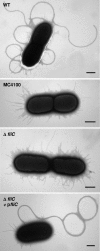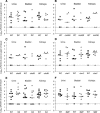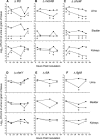Role of motility in the colonization of uropathogenic Escherichia coli in the urinary tract
- PMID: 16239569
- PMCID: PMC1273871
- DOI: 10.1128/IAI.73.11.7644-7656.2005
Role of motility in the colonization of uropathogenic Escherichia coli in the urinary tract
Abstract
Uropathogenic Escherichia coli (UPEC) causes most uncomplicated urinary tract infections (UTIs) in humans. Flagellum-mediated motility and chemotaxis have been suggested to contribute to virulence by enabling UPEC to escape host immune responses and disperse to new sites within the urinary tract. To evaluate their contribution to virulence, six separate flagellar mutations were constructed in UPEC strain CFT073. The mutants constructed were shown to have four different flagellar phenotypes: fliA and fliC mutants do not produce flagella; the flgM mutant has similar levels of extracellular flagellin as the wild type but exhibits less motility than the wild type; the motAB mutant is nonmotile; and the cheW and cheY mutants are motile but nonchemotactic. Virulence was assessed by transurethral independent challenges and cochallenges of CBA mice with the wild type and each mutant. CFU/ml of urine or CFU/g bladder or kidney was determined 3 days postinoculation for the independent challenges and at 6, 16, 48, 60, and 72 h postinoculation for the cochallenges. While these mutants colonized the urinary tract during independent challenge, each of the mutants was outcompeted by the wild-type strain to various degrees at specific time points during cochallenge. Altogether, these results suggest that flagella and flagellum-mediated motility/chemotaxis may not be absolutely required for virulence but that these traits contribute to the fitness of UPEC and therefore significantly enhance the pathogenesis of UTIs caused by UPEC.
Figures






Similar articles
-
Expression of flagella is coincident with uropathogenic Escherichia coli ascension to the upper urinary tract.Proc Natl Acad Sci U S A. 2007 Oct 16;104(42):16669-74. doi: 10.1073/pnas.0607898104. Epub 2007 Oct 9. Proc Natl Acad Sci U S A. 2007. PMID: 17925449 Free PMC article.
-
Uropathogenic Escherichia coli flagella aid in efficient urinary tract colonization.Infect Immun. 2005 Nov;73(11):7657-68. doi: 10.1128/IAI.73.11.7657-7668.2005. Infect Immun. 2005. PMID: 16239570 Free PMC article.
-
Iron limitation induces motility in uropathogenic E. coli CFT073 partially through action of LpdA.mBio. 2024 Jul 17;15(7):e0104824. doi: 10.1128/mbio.01048-24. Epub 2024 Jun 14. mBio. 2024. PMID: 38874412 Free PMC article.
-
Virulence factors of uropathogenic E. coli and their interaction with the host.Adv Microb Physiol. 2014;65:337-72. doi: 10.1016/bs.ampbs.2014.08.006. Epub 2014 Nov 4. Adv Microb Physiol. 2014. PMID: 25476769 Review.
-
Covert operations of uropathogenic Escherichia coli within the urinary tract.Traffic. 2005 Jan;6(1):18-31. doi: 10.1111/j.1600-0854.2004.00251.x. Traffic. 2005. PMID: 15569242 Free PMC article. Review.
Cited by
-
Fur Represses Adhesion to, Invasion of, and Intracellular Bacterial Community Formation within Bladder Epithelial Cells and Motility in Uropathogenic Escherichia coli.Infect Immun. 2016 Oct 17;84(11):3220-3231. doi: 10.1128/IAI.00369-16. Print 2016 Nov. Infect Immun. 2016. PMID: 27572332 Free PMC article.
-
GadE regulates fliC gene transcription and motility in Escherichia coli.World J Clin Infect Dis. 2020 May 15;10(1):14-23. doi: 10.5495/wjcid.v10.i1.14. World J Clin Infect Dis. 2020. PMID: 32728533 Free PMC article.
-
Bacterial chemotaxis in human diseases.Trends Microbiol. 2023 May;31(5):453-467. doi: 10.1016/j.tim.2022.10.007. Epub 2022 Nov 19. Trends Microbiol. 2023. PMID: 36411201 Free PMC article. Review.
-
Conjugative plasmid transfer and adhesion dynamics in an Escherichia coli biofilm.Appl Environ Microbiol. 2009 Nov;75(21):6783-91. doi: 10.1128/AEM.00974-09. Epub 2009 Aug 28. Appl Environ Microbiol. 2009. PMID: 19717626 Free PMC article.
-
Cross Talk between MarR-Like Transcription Factors Coordinates the Regulation of Motility in Uropathogenic Escherichia coli.Infect Immun. 2018 Nov 20;86(12):e00338-18. doi: 10.1128/IAI.00338-18. Print 2018 Dec. Infect Immun. 2018. PMID: 30275009 Free PMC article.
References
-
- Adamo, R., S. Sokol, G. Soong, M. I. Gomez, and A. Prince. 2004. Pseudomonas aeruginosa flagella activate airway epithelial cells through asialoGM1 and toll-like receptor 2 as well as toll-like receptor 5. Am. J. Respir. Cell Mol. Biol. 30:627-634. - PubMed
-
- Ausubel, F. M., R. Brent, R. E. Kingston, D. D. Moore, J. G. Seidman, J. A. Smith, and K. Struhl. 1995. Current protocols in molecular biology. John Wiley & Sons, Inc., New York, N.Y.
-
- Bahrani-Mougeot, F. K., E. L. Buckles, C. V. Lockatell, J. R. Hebel, D. E. Johnson, C. M. Tang, and M. S. Donnenberg. 2002. Type 1 fimbriae and extracellular polysaccharides are preeminent uropathogenic Escherichia coli virulence determinants in the murine urinary tract. Mol. Microbiol. 45: 1079-1093. - PubMed
-
- Beuzón, C. R., and D. W. Holden. 2001. Use of mixed infections with Salmonella strains to study virulence genes and their interactions in vivo. Microbes Infect. 3:1345-1352. - PubMed
Publication types
MeSH terms
Substances
Grants and funding
LinkOut - more resources
Full Text Sources
Other Literature Sources
Medical
Molecular Biology Databases

